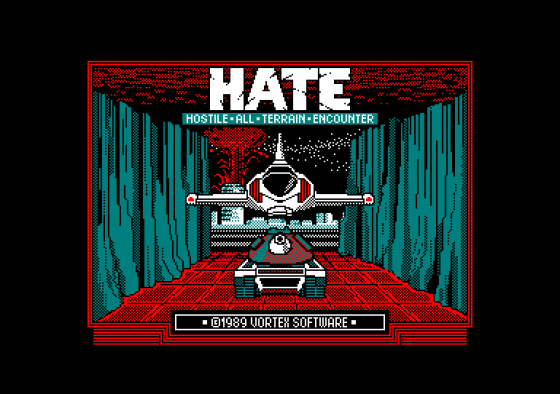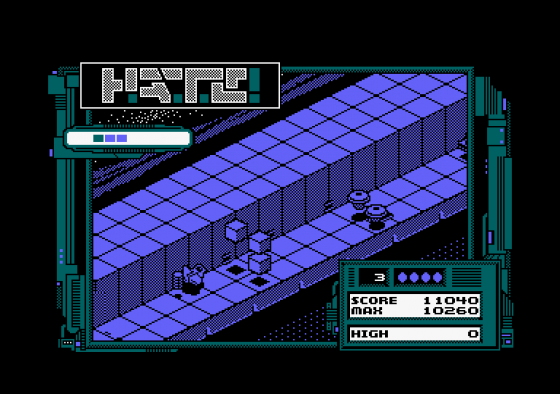
Amstrad Action
 1st July 1989
1st July 1989
Categories: Review: Software
Author: PbM
Publisher: Gremlin
Machine: Amstrad CPC464
Published in Amstrad Action #46
H.A.T.E.
339 years in the future, audio/visual training aids and military simulators have progressed a bit. Fighter pilots and tank commanders don't get experience from being strapped into obscure boxes with flickery screens to watch - they get sent to Stripworld, an obstacle filled planet that tests even the toughest.
Hostile All Terrain Encounter (H.A.T.E. for short) is a shoot-'em-up based around this simple scenario. Your mission starts off on a runway in zone one, with a Star Fighter sitting on the tarmac. The screen starts to scroll diagonally and it's laser time!
After annihilating the alien defences on the first stage, you land automatically at a shorter airstrip where a Ground Assault Vehicle is parked. This hovers at a constant distance above the ground, but has the added advantage of being able to lob shells over terrain. Then you swap transport again, and hopefully progress through all thirty stages.

Piece of cake, except... On each stage are nuclear reactors. When destroyed, these leave a plasma cell for you to pick up and tow to the end of the stage. You need at one to finish each level, otherwise you're blown up at the last barrier and lose one of your four lives. Plasma cells, however, absorb one hit on your vehicle: destroying themselves in the process.
Pitted against you are various simulated alien hazards: mines, fighters, missiles, bolts and saucers, to name a few. These pop up out of sliding trapdoors, and would be easy to zap if there were not quite so many of them.
Because H A.T.E. is a simulator, losing all four lives doesn't automatically kill you: if you've managed to get past level two then you're sent back two stages. Two scores are shown to reflect this: the best you've managed on the mission and your present score.

Although four colours are used for the whole screen, just two appear on the playing area. All the ships and aliens are very well designed though, and are distinct from the background. Occasionally you get disorientated, unsure of what's in front of what: more colour could have prevented this. The scrolling is silky smooth, with no glitching on the playing area at all.
One outstanding part to the game is the sound. Benn Dalglish has done something really special with the music soundtrack. In fact, I suspect that the loudspeaker gets a little bit overloaded at times! The spot effects are boisterous too, and turning up the volume gets the neighbours complaining.
H.A.T.E., starts off easy, but you soon need some fancy stunts with your vehicles to keep progressing. Games can last a long time because of the send back feature, and it's possible to come back fighting from a losing position because excess plasma cells mean extra lives. The game's very engrossing, for a shoot-'em-up!

The only problems are that it doesn't look particularly special for an 1989 game, and if you get through all thirty levels, you probably wouldn't want to play it again. Well, not much anyway.
Second Opinion
It's simply too frustrating to get to level six or seven and then be sent back to stage two! I can stand the failure, it's the being destroyed on the finish line that gets me. Great tune spoilt by a frustrating game.
First Day Target Score
Stage 11 (Fighter Pilot)
Green Screen View

Mostly OK.
The 3D Man
Vortex Software have done similar games in the dim and distant past (Highway Encounter, Mastergame AA2; Alien Highway, Rave AA9). All have been designed by Costa Panayi, a programmer of considerable worth. Let's hope his next effort isn't so long in coming!
Verdict
Graphics 71%
P. Nice scrolling.
N. Looks too plain.

Sonics 90%
P. Blast to the beat.
P. Good effects.
Grab Factor 85%
P. Anarchy rules.
P. Action rarely stops.
Staying Power 82%
P. Send back rule keeps you playing.
N. Not too difficult to complete?
Overall 81%
P. More please Mr. Panayi!








